Renaissance in the Low Countries
| Renaissance |
|---|
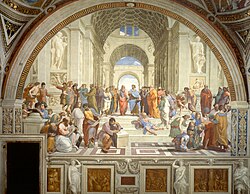 |
| Aspects |
| Regions |
| History and study |
The Renaissance in the Low Countries was a cultural period in the Northern Renaissance that took place in around the 16th century in the Low Countries (corresponding to modern-day Belgium, the Netherlands and French Flanders).
Culture in the Low Countries at the end of the 15th century was influenced by the
Geopolitical situation and background
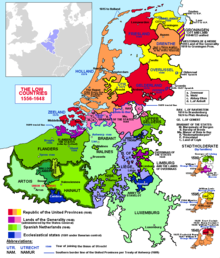
In 1500, the
Two factors determined the fate of the region in the 16th century. The first was the union with the kingdom of Spain through the 1496 marriage of
A second factor included religious developments. The
Influence of the Italian Renaissance

Trade in the port of Bruges and the textile industry, mostly in Ghent, turned Flanders into the wealthiest part of Northern Europe at the end of the 15th century. The Burgundian court dwelled mostly in Bruges, Ghent and Brussels. The nobles and rich traders were able to commission artists, creating a class of highly skilled painters and musicians who were admired and requested around the continent.[3]
This led to frequent exchanges between the Low Countries and Northern Italy. Examples are Italian architects
Before 1500, the Italian Renaissance had little or no influence above the Alps. After this Renaissance influences moved northward, but unlike the Italian Renaissance, Gothic elements remained important. The revival of the classical period is also not a central theme like in Italy, the "rebirth" shows itself more as a return to nature and earthly beauty.[3]
Renaissance in the Low Countries
Art
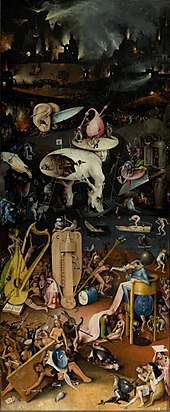

Fifteenth-century painting in the Low Countries still shows strong religious influences, contrary to the Germanic painting. Even after 1500, when Renaissance influences begin to show, the influence of the masters from the previous century leads to a largely religious and narrative style of painting.
The first painter showing the marks of the new era is Hieronymus Bosch. His work is strange and full of seemingly irrational imagery, making it difficult to interpret.[1] Most of all it seems surprisingly modern, introducing a world of dreams that highly contrasts with the traditional style of the Flemish masters of his day.
After 1550, the Flemish and Dutch painters begin to show more interest in nature and in beauty an sich, leading to a style that incorporates Renaissance elements, but remains very far from the elegant lightness of Italian Renaissance art,[3] and directly leads to the themes of the great Flemish and Dutch Baroque painters: landscapes, still lifes and genre painting – scenes from everyday life.[1]
This evolution is seen in the works of
The
Architecture and sculpture
As in painting, Renaissance architecture took some time to reach the Low Countries, and did not entirely supplant Gothic elements.[4] The most important sculptor in the Southern Netherlands was Giambologna, who spent most of his career in Italy. An architect directly influenced by the Italian masters was Cornelis Floris de Vriendt, who designed the city hall of Antwerp, finished in 1564.

In sculpture, however, 15th-century Netherlandish artists, while adhering to Christian subjects, developed techniques and a naturalistic style which compares favorably to the work of early-Renaissance Italian contemporaries such as Donatello. Claus Sluter (fl. ~1400) produced works such as the Well of Moses with a dynamism almost unknown at the turn of the 15th century; and Dutch-born Nikolaus Gerhaert van Leyden (b. ~1420) made sculptures such as "Man Meditating", which even today appear more "modern" than does Italian Quattrocento carving.
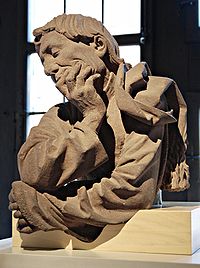
In the early-17th century Dutch Republic, Hendrick de Keyser plays an important role in developing the Amsterdam Renaissance style, not slavishly following the classical style but incorporating many decorative elements, giving a result that could also be categorized as Mannerism. Hans Vredeman de Vries was another important name, primarily as a garden architect.
Music
While in painting the Low Countries were leading Northern Europe, in music the
Although there is no reference to antiquity, there is a clear Flemish "Renaissance consciousness", as indicated by the words of Flemish theorist Johannes Tinctoris, who said of these composers: "Although it is beyond belief, nothing worth listening to had been composed before their time".[1]
Renaissance elements in the music are the return from the "divine origin" of music to earthly beauty and sensory joy. The music becomes more structured, balanced and melodic. Whereas in the Middle Ages the choice of instruments was free, composers now start to organize instruments into homogeneous groups, and write music specifically for certain arrangements.[3]
Josquin des Prez was the most celebrated composer during the High Renaissance, and during his career enjoyed the patronage of three popes. Equally at ease in secular and religious music, he can be considered the first musical genius we know of.[1]
Other important composers from the Low Countries were
Literature
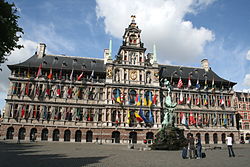
In the middle of the 16th century, a group of
The most important genre was music publishing, especially psalms. The Souterliedekens publication is one of the most important sources for the reconstruction of Renaissance folksongs. Later publishing was heavily influenced by the rebellion against the Spanish: heroic battle songs and political ballads ridiculing the Spanish occupants.
Best remembered of the writers is
Other important names are
Science
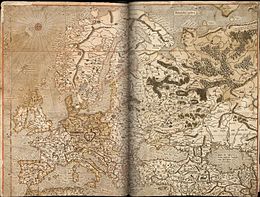
The new age presents itself in science as well. Flemish anatomist Andreas Vesalius's life typically shows both the new possibilities and the troubles that came with them. He delivered ground-breaking work on human anatomy, after centuries of disregard for it. This earned him great respect from some, but also caused several enquiries into his methods (dissection of the human body) and the religious implications of his work.
While Vesalius performed ground-breaking work in rediscovering the human body, Gerardus Mercator, as one of the leading cartographers of his time, did the same for rediscovering the outside world. Mercator too came into trouble with the Church because of his beliefs, and spent several months in jail after a conviction for heresy.
Both scientists' lives show how the Renaissance scientist is not afraid of challenging what has been taken for granted for centuries, and how this leads to problems with the all-powerful Catholic Church.
Though the invention of the printing press by
See also
Political situation
Arts
References
- ^ ISBN 0-8109-3442-6.
- ISBN 0-582-78464-6.
- ^ ISBN 90-5035-222-7.
- OCLC 52849131.
- ^ One or more of the preceding sentences incorporates text from a publication now in the public domain: Gosse, Edmund William (1911). "Dutch Literature § Houwaert". In Chisholm, Hugh (ed.). Encyclopædia Britannica. Vol. 8 (11th ed.). Cambridge University Press. p. 721.
- ^ E. L. Eisenstein: The Printing Revolution in Early Modern Europe, Cambridge, 1993 pp.13–17, quoted in: Angus Maddison: Growth and Interaction in the World Economy: The Roots of Modernity, Washington 2005, p.17f.
